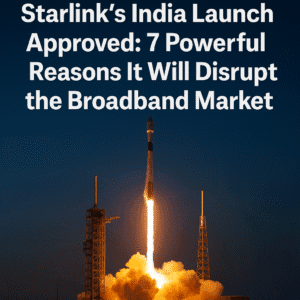Starlink’s India Launch Approved: 7 Powerful Reasons It Will Disrupt the Broadband Market
Starlink has cleared the final regulatory hurdle in India, securing authorization from space regulator IN-SPACe to operate its satellite broadband services until 2030, joining Eutelsat OneWeb and Reliance Jio-SES as approved providers. However, this approval marks the start of the real challenge: Starlink must now acquire spectrum from the government, build critical ground infrastructure like gateway stations, and rigorously demonstrate compliance with India’s national security requirements before launching services.
Demonstrating strategic urgency, Starlink has already signed its first commercial enterprise deals with Indian partners to target business and government customers even before its consumer spectrum is finalized, while also advancing plans for direct-to-consumer sales. The competitive landscape intensifies as Amazon’s ambitious Project Kuiper, planning a larger 10-gateway network, awaits its own regulatory approvals.
Ultimately, this milestone matters because satellite broadband promises to bridge India’s significant digital divide, bringing reliable connectivity to remote regions, enhancing critical services like disaster response, and offering new choices nationwide – making the race to translate this regulatory green light into operational service the next crucial phase for millions awaiting better internet access.

Starlink’s India Launch Approved: 7 Powerful Reasons It Will Disrupt the Broadband Market
Elon Musk’s Starlink has achieved a critical milestone, securing the final regulatory approval from India’s space authority, IN-SPACe, to operate its satellite broadband services. This authorization, valid until July 2030, specifically covers the Starlink Gen1 constellation, clearing the path for commercial operations. However, the real work – and the true competition – starts now.
Beyond the Headline: What the Approval Actually Means
This isn’t just a rubber stamp. The IN-SPACe clearance details the operational blueprint:
- Specific Spectrum Granted: Starlink is authorized to use precise frequency bands for both user connections (14.0–14.5 GHz uplink, 10.7–12.7 GHz downlink) and critical gateway links connecting satellites to ground stations (27.5–29.1 GHz & 29.5–30 GHz uplink, 17.8–18.6 GHz & 18.8–19.3 GHz downlink). This technical specificity is crucial for avoiding interference and planning infrastructure.
- Joining the Pioneers: Starlink becomes the third entity, following Eutelsat OneWeb and Reliance Jio’s partnership with SES, to secure both the essential GMPCS license (from the DoT) and now this space operations authorization. The regulatory gate is officially open for them.
The Critical To-Do List: From Paper to Reality
The IN-SPACe nod is permission to begin the complex groundwork, not an instant service launch. Starlink faces immediate, tangible challenges:
- Spectrum Acquisition: While operational bands are approved, Starlink must now formally acquire the spectrum from the Department of Telecommunications (DoT). The method (administrative allocation vs. auction) and associated costs are still being finalized by the government based on TRAI recommendations. This is a major financial and strategic variable.
- Building the Ground Game: Starlink plans at least three gateway earth stations across India. Securing land, building facilities, installing sensitive equipment, and integrating them with the global network is a significant logistical and engineering undertaking.
- Proving Security & Compliance: Before commercial rollout, Starlink must undergo rigorous trials and testing to demonstrate its network meets India’s stringent national security requirements. The DoT is expected to grant trial spectrum specifically for this purpose.
Strategic Moves Hint at Aggressive Timeline
Despite these hurdles, Starlink isn’t waiting idly:
- Enterprise First: Signaling an intent to monetize quickly, Starlink has already inked its first commercial agreements with Indian VSAT providers. This targets enterprise and government (B2B/B2G) customers, allowing revenue generation even before the consumer-facing spectrum is finalized and retail services launch.
- Laying Consumer Foundations: Sources indicate plans for direct-to-consumer sales via its website are advancing, though final retail pricing remains under wraps. This groundwork positions them for a rapid consumer switch-on once spectrum is secured.
The Competitive Landscape Heats Up
Starlink’s entry intensifies India’s nascent but high-potential satellite broadband market:
- The Incumbents: Eutelsat OneWeb and Jio-SES have their approvals and are building their operations. Jio’s massive existing user base and distribution network pose a unique challenge.
- The Looming Giant: Amazon’s Kuiper: Project Kuiper, arguably Starlink’s biggest global rival, is still awaiting its IN-SPACe and DoT approvals despite completing checks. Kuiper’s ambitious plans for 10 gateway stations and dual points of presence (Mumbai, Chennai) suggest a massive infrastructure commitment, but they are now playing catch-up in the regulatory race. Their application awaits an upcoming inter-ministerial committee meeting.
The Human Impact: Why This Matters Beyond Tech Circles
This isn’t just about corporate competition. Satellite broadband promises:
- Bridging the Digital Chasm: Reliable, high-speed internet for remote villages, difficult terrains, and underserved regions where fiber is impractical.
- Critical Connectivity: Enhanced communication for disaster management, transportation (shipping, airlines), and critical infrastructure monitoring.
- Economic Catalyst: Enabling digital services, education, telemedicine, and e-commerce in areas previously offline, fostering new opportunities.
- Consumer Choice: Introducing a new option for urban and suburban users seeking alternatives to traditional wired broadband, potentially driving innovation and competitive pricing.
The Verdict: A Launchpad, Not the Destination
Starlink’s IN-SPACe approval is undeniably significant, marking the end of a long regulatory journey. However, it merely signals the start of an even more complex phase: translating permission into practical, secure, and competitive service. The race to build infrastructure, secure spectrum on viable terms, pass security tests, and capture market share against established players like Jio and ambitious rivals like Amazon Kuiper is where the future of satellite internet in India will truly be decided. For millions of Indians waiting for better connectivity, the countdown to tangible service has finally begun
You must be logged in to post a comment.